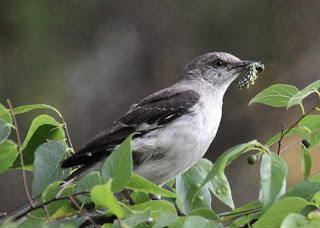One of the evenings I was there I headed out to Enchanted Rock State Park. This is located in a section of Texas called the Edwards Plateau, or "The Hill Country" in marketing terms. It is a beautiful section of Texas and the State Park itself is very nice. The main attraction for most visitors is the hike to the top of Enchanted Rock, 425 ft. in 0.6 miles, which is really only challenging if it is wet. The attractions for me, however, were the various birds flitting through the trees and shrubs around the creek at the base of the rock.
I first arrived after a brief rain and the park was still a bit wet. This Blue-gray Gnatcatcher was one of the many birds eagerly trying to dry off.
As the name of the park suggests, you are constantly walking on either trail or some large rock as you make your way around the park. Some birds are doing the same. I found this Inca Dove and female Northern Cardinal going from rock to rock, as well.
Soon after, I heard a flutter in the tall grass just to my left. As I turned, a male Painted Bunting popped-up about ten feet away and at eye-level. Before I could take his picture he was gone, and it was getting dark. I snapped this picture of sunset over the park with the intent of returning early the next morning.
I arrived the next morning, early and dry. I missed almost the same photo opportunity with another Painted Bunting but was rewarded with good looks at Cassin's Sparrows and Bell's Vireos. The BOTD was this female Orchard Oriole. She flew into a tree to my left with another female and one male. Of the three, she was the the one who stuck around for a picture.
On my way out, this Lark Sparrow seemed to announce the exit of the only human in the park.
For more pictures of this birding trip click here.








